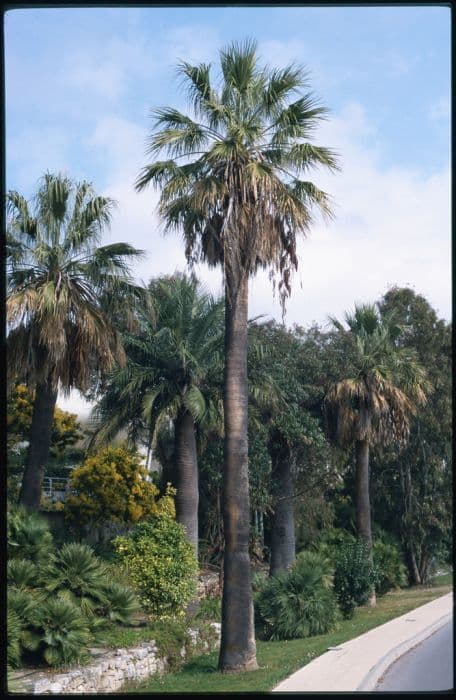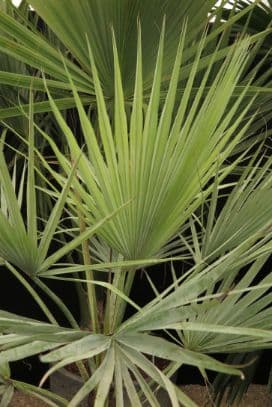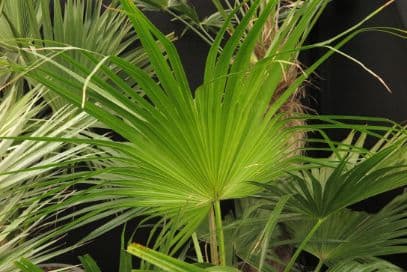Mexican Fan Palm Washingtonia robusta

ABOUT
The Washingtonia robusta, commonly known as the Mexican Fan Palm or Skyduster, is a striking plant recognizable for its tall, slender trunk and distinctive crown of fan-like fronds. The trunk is usually a creamy-gray to light brown color, maintaining a somewhat columnar shape that tapers slightly as it ascends. On top of this trunk sits a dense crown of large, palmate leaves which are bright green to a slightly bluish-green in color. These leaves are arranged in a circular pattern and spread out to create an almost umbrella-like silhouette. Each leaf consists of multiple leaflets that emanate from a single point, resembling the spokes of a fan, hence the name "Fan Palm." The leaflets are long and narrow, sometimes with a little droop at the ends, giving the plant a graceful and elegant appearance. These leaves also have a slightly rough texture on the surface which can gather to form a petticoat of dead leaves hanging below the living foliage, if not pruned. The leaf bases, known as petioles, are equipped with small, sharp teeth that can be quite prickly to the touch. The Washingtonia robusta bears flowers that emerge from within the crown on long, drooping stalks. These inflorescences produce numerous small, white to cream-colored flowers that add to the plant's ornamental value. After flowering, the plant produces small, black fruits that are quite attractive to birds and other wildlife. These fruits are round to oblong, and have a thin flesh covering a hard, solitary seed inside. With its elegant crown of fronds and striking silhouette, the Washingtonia robusta provides a dramatic visual accent in any landscape where it is planted, embodying the quintessential image of a tropical palm tree.
About this plant
 Names
NamesFamily
Arecaceae.
Synonyms
Mexican Fan Palm, Skyduster, Washington Palm.
Common names
Washingtonia filifera var. robusta, Neowashingtonia robusta, Pritchardia robusta, Washingtonia sonorae.
 Toxicity
ToxicityTo humans
The Mexican Fan Palm is not considered toxic to humans. If ingested, it is unlikely to cause any symptoms of poisoning. However, as with many plants, ingesting large amounts could potentially cause stomach discomfort due to the fiber content or natural plant compounds.
To pets
The Mexican Fan Palm is also not considered toxic to pets. Ingestion of this plant is unlikely to cause poisoning in pets such as dogs or cats. As with humans, eating large quantities might result in gastrointestinal upset due to the plant's fiber content.
 Characteristics
CharacteristicsLife cycle
Perennials
Foliage type
Evergreen
Color of leaves
Green
Flower color
White
Height
70 feet (21 meters)
Spread
10 feet (3 meters)
Plant type
Palm
Hardiness zones
9
Native area
Mexico
Benefits
 General Benefits
General Benefits- Shade Provider: The Mexican Fan Palm offers ample shade with its large, fan-shaped leaves, creating cool areas in gardens and urban landscapes.
- Aesthetic Appeal: With its tall, slender trunk and crown of large leaves, it adds an exotic, tropical look to the landscape.
- Erosion Control: The root system can help stabilize soil and prevent erosion in certain environments.
- Habitat for Wildlife: Birds and other small animals use the tree for nesting and as a food source.
- Low Maintenance: Once established, this palm tree requires minimal care and can tolerate drought conditions.
- Adaptability: It is adaptable to a variety of soil types and urban conditions, making it suitable for diverse landscapes.
- Wind Resistance: The flexible trunks and fronds are resistant to wind damage and can withstand coastal conditions.
- Privacy Screen: Tall specimens can act as a natural privacy barrier or screen in residential and commercial properties.
- Urban Tolerance: The Mexican Fan Palm is well-suited for urban environments, tolerating pollution and compacted soils.
- Cultural Symbolism: Often associated with beach and resort imagery, it adds a thematic element to gardens and public spaces.
- Fast Growth: It has a relatively fast growth rate, which allows for quicker establishment and landscape impact.
- Heat Tolerance: The palm is highly tolerant of high temperatures, making it ideal for hot climates.
 Medical Properties
Medical PropertiesThis plant is not used for medical purposes.
 Air-purifying Qualities
Air-purifying QualitiesThis plant is not specifically known for air purifying qualities.
 Other Uses
Other Uses- The fronds of the Mexican Fan Palm can be used for thatching in small-scale roofing projects, providing a natural and esthetically pleasing covering for shelters or huts.
- The fibers from the fronds are ideal for making crafts such as baskets, mats, and hats, offering a sustainable resource for traditional handcrafts.
- Dried Mexican Fan Palm leaves can be repurposed into skirts or costumes for cultural performances or as a part of traditional dress in certain regions.
- The woody trunks, once they're too old and dry, can be carved or used as small landscape timbers, for those interested in natural building materials.
- Mexican Fan Palm seeds may be employed as a food source for livestock, particularly in rural areas where other feed may be scarce.
- During festive seasons, fronds can be used as natural decorations, providing a green touch to holiday festivities or special events.
- Tall and straight trunks of the plant can serve as poles or masts in temporary outdoor structures, taking advantage of their natural strength.
- The Mexican Fan Palm's large leaves can serve as a natural canvas for creative projects or educational materials when treated properly.
- The tree can be incorporated into windbreaks or as a privacy screen, due to its dense growth and tall stature.
- Trunks of mature Mexican Fan Palms may be used in creating unique furniture pieces, such as table bases, emphasizing the beauty of natural forms.
Interesting Facts
 Feng Shui
Feng ShuiThe Mexican Fan Palm is not used in Feng Shui practice.
 Zodiac Sign Compitability
Zodiac Sign CompitabilityThe Mexican Fan Palm is not used in astrology practice.
 Plant Symbolism
Plant Symbolism- Durability: Washingtonia robusta, commonly known as the Mexican Fan Palm, is a hardy plant that can thrive in various environments, symbolizing resilience and the ability to withstand challenges.
- Growth: The Mexican Fan Palm grows tall and fast, representing rapid growth and the achievement of high goals.
- Victory: With its height and prominent presence, the Mexican Fan Palm often conjures images of triumph and success, making it a symbol of victory.
- Longevity: This palm species can live for a long time, which can symbolize longevity and endurance, both personally and professionally.
- Oasis: As a palm commonly found in desert regions, it represents an oasis of life and relief, symbolizing hope and sustenance in difficult times.
 Water
WaterFor a Mexican Fan Palm, regular watering is crucial during its growing season in spring and summer, where it may need watering once a week. Use approximately 15-20 gallons for mature trees and 5-10 gallons for younger ones each time you water. During the cooler months, you can reduce watering to once every two to three weeks. Make sure to water deeply and directly at the base of the palm to encourage proper root growth and to prevent the soil from becoming waterlogged.
 Light
LightMexican Fan Palms thrive best in full sun conditions where they can receive direct sunlight for most of the day. Ideally, plant them in a location that provides a minimum of 6 hours of direct sunlight. They are adaptable, however, and can tolerate some light shade, but for optimal growth and health, a sunny spot in your landscape will yield the best results.
 Temperature
TemperatureThe ideal temperature range for a Mexican Fan Palm is between 70°F and 100°F. However, it can tolerate temperatures as low as 20°F, though it is not frost-tolerant and can be damaged by prolonged exposure to cold. For optimal growth, the palm should be placed in an area where the temperature is consistently warm.
 Pruning
PruningPrune Mexican Fan Palms to remove dead or damaged fronds, typically done annually in the spring or summer. This not only improves the appearance of the palm but also promotes healthy growth and reduces the risk of disease. It is important not to prune green fronds, as this can weaken the palm. The best time for pruning is before the hurricane season if you live in a region prone to such natural events.
 Cleaning
CleaningAs needed
 Soil
SoilThe best soil mix for the Mexican Fan Palm should be well-draining with a sandy loam texture, composed of two parts sand, one part peat, and one part perlite or pumice. The ideal pH for this palm should be slightly acidic to neutral, ranging from 6.0 to 7.0.
 Repotting
RepottingThe Mexican Fan Palm should be repotted every 2-3 years when young to encourage growth, but as it matures, repotting can be done less frequently, as it prefers being slightly root-bound.
 Humidity & Misting
Humidity & MistingThe Mexican Fan Palm thrives in average room humidity. However, it can tolerate lower humidity levels without adverse effects, making it adaptable to most indoor environments.
 Suitable locations
Suitable locationsIndoor
Ensure bright, indirect light, and room to accommodate height.
Outdoor
Full sun to partial shade; protect from severe cold.
Hardiness zone
9-11 USDA
 Life cycle
Life cycleThe Mexican Fan Palm begins its life cycle as a seed, which germinates in moist conditions to produce a small sprout with an initial root system. It then grows into a seedling, developing a slender trunk and a crown of fan-shaped leaves. As it matures into a juvenile plant, it gradually increases in height and the diameter of its trunk expands; this phase can last for several years. Upon reaching maturity, the palm will start to reproduce, producing large clusters of small, creamy-white flowers that are followed by black or brown fruits. Once pollination occurs, the fruits contain seeds that can be dispersed to begin a new life cycle. The Mexican Fan Palm is long-lived, and the adult stage can last for many decades, continuing to grow in height and produce flowers and fruits seasonally.
 Propogation
PropogationPropogation time
Spring-Early Summer
Propogation: The Mexican Fan Palm (Washingtonia robusta) is commonly propagated using seeds as it is the most popular method. The best time to sow seeds is in the spring when the temperature is consistently above 65 degrees Fahrenheit (about 18 degrees Celsius). The seeds are collected from mature fruit and cleaned of any pulp before sowing to prevent fungal issues. They are then sown in a well-draining soil mix and lightly covered with soil. The pot should be kept in a warm, bright location and the soil should be kept consistently moist but not waterlogged. Germination typically occurs within several weeks to a few months, depending on the growing conditions. Once the seedlings have developed a few sets of true leaves, they can be carefully transplanted into individual pots to allow for further growth.









